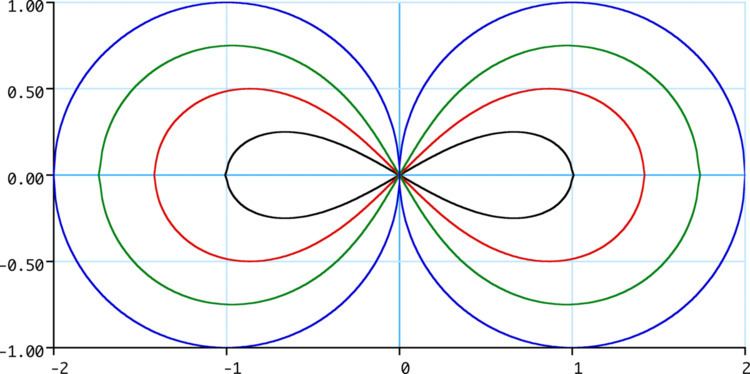 | ||
In algebraic geometry, a lemniscate is any of several figure-eight or ∞-shaped curves. The word comes from the Latin "lēmniscātus" meaning "decorated with ribbons", from the Greek λημνίσκος meaning ribbons, or alternatively may refer to the wool from which the ribbons were made.
Contents
Lemniscate of Booth
Although the name "lemniscate" dates to the late 17th century, the consideration of curves with a figure eight shape can be traced back to Proclus, a Greek Neoplatonist philosopher and mathematician who lived in the 5th century AD. Proclus considered the cross-sections of a torus by a plane parallel to the axis of the torus. As he observed, for most such sections the cross section consists of either one or two ovals; however, when the plane is tangent to the inner surface of the torus, the cross-section takes on a figure-eight shape, which Proclus called a horse fetter (a device for holding two feet of a horse together). The Greek phrase for a horse fetter became the word hippopede, the name for this figure-eight shaped curve, which is also called the lemniscate of Booth. It may be defined algebraically as the zero set of the quartic polynomial
Lemniscate of Bernoulli
In 1680, Cassini studied a family of curves, now called the Cassini oval, defined as follows: the locus of all points, the product of whose distances from two fixed points, the curves' foci, is a constant. Under very particular circumstances (when the half-distance between the points is equal to the square root of the constant) this gives rise to a lemniscate.
In 1694, Johann Bernoulli studied the lemniscate case of the Cassini oval, now known as the lemniscate of Bernoulli (shown above), in connection with a problem of "isochrones" that had been posed earlier by Leibniz. It is analytically described as the zero set of the polynomial
Lemniscate of Gerono
Another lemniscate, the lemniscate of Gerono or lemniscate of Huygens, is the zero set of the quartic polynomial
Others
Other figure-eight shaped algebraic curves include
